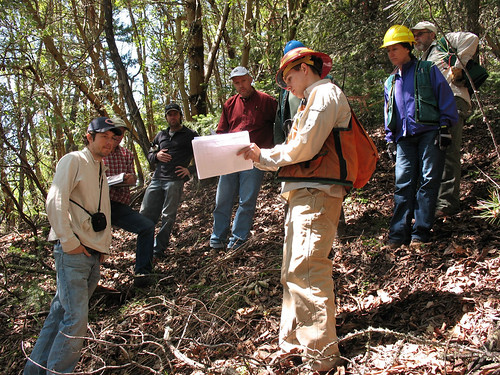
Located at the base of the Ashland Creek Watershed, the city of Ashland, Oregon, is home to nearly 21,000 people and a bustling tourist industry that revolves around world-class theatre experiences. Rogue Valley residents and tourists actively and passionately recreate in the Ashland municipal watershed, of which the upper portion is located primarily on the Rogue River-Siskiyou National Forest.
Like many areas in Southwest Oregon, a history of fire suppression has dramatically changed the way forests could potentially respond to fires. Stands once considered to be fire-adapted and fire-resilient have become densely overgrown. As a result of this fuels buildup, a high-intensity fire could result in the loss of the watershed’s largest trees, which help maintain soil stability and clean drinking water, and provide habitat for a diverse range of wildlife species.
Recognizing the important role forest health plays in Ashland’s successes as a tourist destination and incredible place to live, the U.S. Forest Service, the City of Ashland, The Nature Conservancy, and Lomakatsi Restoration Project established the Ashland Forest Resiliency (AFR) project. Implemented through a ten-year stewardship agreement, the project focuses on key objectives in watershed health, including:
- Reducing the risk of large-scale wildfire.
- Helping large, older trees survive fire, insects and disease.
- Restoring a healthy forest ecosystem.
- Upholding and protecting critical watershed values such as human life and property, abundant and clean drinking water, ecological sustainability, and wildlife habitat.
One particular watershed resident has become a community mascot of sorts, symbolic to locals as to why nature matters and what it can provide if they work together.
The Pacific fisher, a relative of the mink and the weasel, is sometimes thought to be secretive and relatively difficult to track in most parts of southwest Oregon. The U.S. Fish and Wildlife Service is proposing to list the West Coast distinct population segment of fisher as threatened and the population in the Ashland Watershed is considered very important to the larger northern California-southern Oregon population. Surprisingly, the Forest Service has identified 26 fishers in the Ashland Creek Watershed, and 21 of them are being monitored, suggesting that perhaps these elusive creatures are more socially adapted than previously believed.
In 2013, these monitoring efforts identified a den site of a mother and her kit within a helicopter thinning unit, where cutting had just been completed several days prior. A 600-meter buffer around the den tree to was established to avoid scaring mother and kit. All operations, including the helicopter removal of the harvested trees, were halted until the fisher family moved several weeks later. Though a difficult decision to make, the success of this effort to protect the mother and her kit was the result of both diligent monitoring and the strong collaborative approach AFR has taken.
The presence of Pacific fisher in the watershed has led to a community awareness of the species, and resulted in the recognition of fisher as being iconic of the watershed and a symbol of the collaborative efforts by the partners involved in the AFR Project. The Watershed Art Group recently asked area artists to submit proposals for a commissioned sculpture depicting the species, to be installed as part of an envisioned “art trail” in a portion of the extensive watershed trail system. Jeremy Criswell’s winning entry, a 250-pound, three-dimensional tile mosaic fisher, made its public debut at the Rogue Valley Earth Day celebration in April, with a follow-up contest to name the statue. The winning name will be announced June 9th. Chloe, Lily, Left, Butch, and Squirt are names of some of the actual, real-life collared fishers in the watershed.
The next phase of watershed restoration work, which will also treat privately-owned lands as a result of a Chiefs’ Joint Landscape Restoration Project award with the Natural Resource Conservation Service, will bring additional partners and collaborators to the table, including watershed landowners, U.S. Fish and Wildlife Service, Oregon Department of Forestry, and the Jackson County Soil and Water Conservation District.
The successes of the AFR project have highlighted the natural traits of a watershed at both local and larger scales, and have been possible in part due to the community rallying in support of the Pacific fisher. As Shakespeare wrote, “One touch of nature makes the whole world kin.”
This post is part of a series featuring the Forest Service’s work on restoration across the country.
